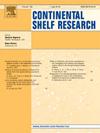环境DNA (Environmental DNA, eDNA)检测显示,定海湾浮游生物和底栖真核生物群落具有较强的连通性和相似的共生模式
IF 2.2
3区 地球科学
Q2 OCEANOGRAPHY
引用次数: 0
摘要
探索海岸带浮游生物与底栖真核生物之间的关系,对于我们进一步了解环境条件对微生物生态系统的影响,以及海岸带生物资源与生态景观的综合管理具有重要意义。本研究采用环境DNA (environmental DNA, eDNA)、共生网络分析和SourceTracker分析方法对福建定海湾海水和沉积物样本进行了分析。比较了不同生境真核生物,特别是微真核生物的群落结构、多样性和共生模式。结果表明:(1)浮游与底栖真核生物群落存在一定差异。底栖真核生物的多样性明显高于浮游真核生物。透明度、TDS (total dissolved solids)和盐度等环境因子与浮游真核生物显著相关,而底栖真核生物仅与电导率相关。此外,浮游生物群落表现出强烈的距离衰减模式,而底栖生物群落则没有。(2)浮游真核生物与底栖真核生物之间存在较强的连通性。浮游和底栖真核生物共享零半径操作分类单元(ZOTUs)的比例分别为96.70%和77.65%,其中92%以上的共享ZOTUs在两种生境间差异不显著。此外,SourceTracker分析显示,59.70%的底栖生物来自浮游生物群落,91.22%的浮游生物来自底栖生物群落。桡足类、硅藻、鞭毛类和纤毛虫等浮游生物在某些生命阶段生活在沉积物中,底栖动物的生命周期中往往有一个浮游幼虫阶段。另一方面,我们的研究区域位于潮间带和潮下带,环境条件特殊,受潮汐、风和河流淡水的影响,地底水的不断混合也是一个可能的原因。(3)共现网络分析表明,两个生境真核生物的共现模式具有相当程度的相似性。浮游和底栖群落均以正相关为主,正相关和负相关比例在群落间无显著差异。本文章由计算机程序翻译,如有差异,请以英文原文为准。
Environmental DNA (eDNA) detection reveals strong connectivity and similar co-occurrence patterns of planktonic and benthic eukaryote communities in Dinghai bay
Exploring the relationship between planktonic and benthic eukaryotes in coastal zones is of great significance for us to further understand the influence of environmental conditions on microbial ecosystems and the integrated management of biological resources and ecological landscape in coastal areas. In this study, environmental DNA (eDNA), co-occurrence network analysis and the SourceTracker analysis were used to analyze seawater and sediment samples from Dinghai Bay, Fujian Province. Community structure, diversity, and co-occurrence patterns of eukaryotes, especially microeukaryotes in different habitats were compared. The results showed that: (1) There are differences between planktonic and benthic eukaryote communities to some extent. The diversity of benthic eukaryotes is significantly higher than that of planktonic eukaryotes. Environmental factors such as transparency, TDS (total dissolved solids) and salinity are significantly correlated with planktonic eukaryotes, while benthic eukaryotes are only correlated with conductivity. In addition, the planktonic community shows a strong distance-decay pattern while the benthic community did not. (2) There is strong connectivity between planktonic and benthic eukaryotes. The proportion of shared zero-radius operational taxonomic units (ZOTUs) in planktonic and benthic eukaryotes was 96.70% and 77.65%, respectively, and more than 92% of shared ZOTUs were not significantly different between two habitats. In addition, SourceTracker analysis showed that 59.70% of the benthos came from the planktonic community and 91.22% of the plankton from the benthic community. Plankton such as copepod, diatoms, dinoflagellata and ciliates live in sediments at some life stages,and there is often a planktonic larval stage in the life cycle of benthos. On the other hand, our study area is located in the intertidal zone and subtidal zone with special environmental conditions, which is influenced by tides, winds and river freshwater, and the constant mixing of surface and bottom water is also a possible reason. (3) The co-occurrence network analysis shows that the co-occurrence patterns of eukaryotes in the two habitats are similar to a considerable degree. Positive correlations are dominant in both planktonic and benthic communities, and the ratio of positive and negative correlations has no significant difference between two communities.
求助全文
通过发布文献求助,成功后即可免费获取论文全文。
去求助
来源期刊

Continental Shelf Research
地学-海洋学
CiteScore
4.30
自引率
4.30%
发文量
136
审稿时长
6.1 months
期刊介绍:
Continental Shelf Research publishes articles dealing with the biological, chemical, geological and physical oceanography of the shallow marine environment, from coastal and estuarine waters out to the shelf break. The continental shelf is a critical environment within the land-ocean continuum, and many processes, functions and problems in the continental shelf are driven by terrestrial inputs transported through the rivers and estuaries to the coastal and continental shelf areas. Manuscripts that deal with these topics must make a clear link to the continental shelf. Examples of research areas include:
Physical sedimentology and geomorphology
Geochemistry of the coastal ocean (inorganic and organic)
Marine environment and anthropogenic effects
Interaction of physical dynamics with natural and manmade shoreline features
Benthic, phytoplankton and zooplankton ecology
Coastal water and sediment quality, and ecosystem health
Benthic-pelagic coupling (physical and biogeochemical)
Interactions between physical dynamics (waves, currents, mixing, etc.) and biogeochemical cycles
Estuarine, coastal and shelf sea modelling and process studies.
 求助内容:
求助内容: 应助结果提醒方式:
应助结果提醒方式:


